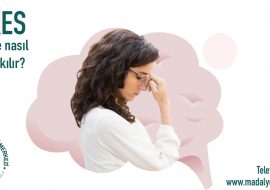Stress, the natural reaction of the body during any moment of danger that requires adaptation or response, can be triggered by both real and perceived threatening situations. The observed situation of danger can be an actual event or a situation perceived as “dangerous” by the mind. The stress response that emerges to protect the individual can disrupt the quality of life and functionality when excessively observed. Many life events in daily life, such as school, home, family, and work environments, can become stressful. Stress can manifest at the physical, emotional, cognitive, and behavioral levels, not only in the face of negative life events but also in situations that require adaptation, such as changes in work or city.
In addition to everyday life events, when traumatic experiences occur or in situations with unforeseeable or uncertain conditions, internal conflicts arise, becoming a source of stress. Stress becomes inevitable when existing coping mechanisms prove insufficient in times of change or situations requiring adaptation.
What is Stress?
The term stress, commonly used to describe mental tension, is an ancient phenomenon dating back to the existence of humanity. The factors causing stress have evolved along with the changes in the process from ancient times to the present. Experiencing stress from the past to the present has been related to how individuals perceive the stress-inducing factor. Therefore, the concept of stress is a variable one from person to person.
To define and understand stress, many researchers have sought answers to the question “What is stress?” Hans Selye, one of the first and important scientists researching stress, defines stress as a general response of the individual to various environmental stimuli. According to Doğan Cüceloğlu, stress is the effort expended beyond the physical and psychological limits due to maladaptive conditions in the physical and social environment. Traumatic events, natural disasters, accidents, pandemics, negative aspects of work life, economic conditions, life events such as marriage-divorce, moving, and daily problems (losing an object, being late somewhere) are among the stimuli that cause stress.
Why Do We Experience Stress?
Although stress is often referred to as a negative condition, it has a vital and protective significance in human life. When a person sees a wild predator approaching, the body activates an “alarm system.” In moments of danger, the nervous system releases cortisol (stress hormone) and adrenaline hormones. These hormones enable the body to enter an “alarm state.” Heart rate increases, muscles tense, breathing intensifies, and the body becomes ready to fight the danger. This automatic response of the nervous system is called the Fight-Flight response and is activated automatically. Despite the fact that almost no one faces a wild predator in daily life, cortisol and adrenaline release often occur, muscles tense, blood flow accelerates, and breathing intensifies.
The body and mind struggle to distinguish how dangerous daily life events are; when it receives signals of internal or external danger, it activates the Fight-Flight response. In moments such as a promotion or approaching deadline for a task, it behaves similarly to when a wild predator is approaching. Therefore, one needs to be alert frequently. In the face of an approaching “danger,” to survive, the individual activates the alarm system physically, emotionally, cognitively, and behaviorally. Being constantly alert and trying to cope with danger becomes exhausting in the long run, reducing functionality. The vital alarm system, when used excessively, becomes dysfunctional and adversely affects psychological well-being.
Stress Symptoms.
The symptoms of stress that occur in the body in response to environmental stimuli causing stress can manifest in four different areas. These symptoms become more pronounced on individuals in conjunction with excessive stress. Excessive stress reveals itself with various symptoms in the physical, mental, emotional, and social domains.
Despite encountering stressful situations in many aspects of daily life, individuals may not be aware that they are experiencing stress in many cases. When experienced frequently, individuals may become accustomed to this situation, consider it normal, or may not associate their problems with stress. However, stress has many physical, emotional, cognitive, and behavioral symptoms.
Physical Symptoms:
Heart palpitations, aches and a feeling of fatigue, muscle tension, accelerated breathing, gastrointestinal problems (constipation, diarrhea, stomach and intestinal disorders), weakness, chest pain, nausea, dizziness, frequent illnesses, weakening of the immune system, and loss of sexual desire are observable.
*Pains (back, head, muscle pain),
*Teeth grinding and jaw clenching,
*Stomach and intestinal problems (diarrhea, constipation, colitis, indigestion),
*Excessive sweating,
*Changes in appetite,
*Loss of energy.
Mental Symptoms:
Forgetfulness, difficulty making decisions, a constant anxious state, focusing on the negative aspects of events, weakening judgment skills, memory problems, and difficulty concentrating can be observed.
*Memory loss,
*Concentration problems,
*Confusion and indecision.
Emotional Symptoms:
Reluctance, inability to enjoy things that were enjoyable before, feeling lonely, depression, feeling unhappy or joyless, pessimism, a sense of overwhelm, restlessness, sensitivity, irritability, anger outbursts, and anxiety disorders can be observed.
*Feeling anxious,
*Anger outbursts,
*Sudden changes in mood,
*Excessive sensitivity.
Social Symptoms:
*Distrust of others,
*Tendency to blame and embarrass the other party,
*Estrangements.
Behavioral Symptoms:
Sleep disorders (oversleeping, difficulty falling asleep, fragmented sleep), appetite problems (overeating or loss of appetite), anxiety-related behaviors (nail-biting, hair pulling), procrastination, inability to start or sustain a task, isolation from people, introversion, and substance use can be observed.
What Causes Stress?
While negative situations (job loss, divorce) generally appear among the causes of stress, new beginnings (starting a new job), positive changes in life (getting married) can also be sources of stress. Stress is closely related to individuals’ psychological resilience and their perception of events. The reactions individuals give to internal and external changes create individual stressors, so there is no single answer to the question “What causes stress?”
As life continues, everything is in a state of change, and individuals try to adapt to these environmental, physical, and psychological changes. The body releases stress hormones in moments of danger or when it feels it has lost control over events. Thanks to these hormones, it becomes easier to control or adapt to stressful situations. However, individuals who have difficulty returning to balance after stressful situations may experience mental exhaustion from time to time.
What Are the Causes of Stress?
Many factors in life can be a source of stress. Life events such as work, school, changing homes, starting university, finishing school, promotions, or the loss of a loved one, illness, natural disasters, and traumatic events such as accidents can be stressors. Relational difficulties, intense work conditions, becoming a parent, getting married, divorcing, financial difficulties can also be among life events that cause stress. However, stress may not always originate from external factors.
Having an anxious or pessimistic disposition, feeling excessive guilt, having an irrational thought structure, being unable to tolerate uncertainty, having weak flexibility skills, perfectionism, either-or style of thinking, negative perceptions about self-worth, and excessive negative inner voices (like it won’t happen, you can’t do it) are also factors observed among the internal triggers of stress.
Stress’s Physiological and Psychological Effects
Stress, which plays a significant role in individuals’ physical and mental well-being, has various physiological and psychological effects. Events perceived as threats by the mind lead to mental stimulation, which then transforms into physical arousal. Following this process, bodily responses and the effects of stress on the body become apparent.
Cardiovascular Diseases
During stress, the heart rate and blood flow in the vessels increase to provide more energy to the body. Therefore, one of the most important disorders that can be considered among the effects of stress is cardiovascular diseases.
Chronic Pains
Stress hormones released during stress affect the immune system. Rheumatoid arthritis, an immune system-related disorder, leads to the development of chronic pains in the body. Fibromyalgia syndrome, causing musculoskeletal pains, and increased pain in patients with rheumatoid arthritis during stressful periods have been observed.
Immune System
Stress negatively affects the immune system. Patients with autoimmune disorders experience an increase in their symptoms during stressful periods.
Digestive System
Excessive stress disrupts the balance of the digestive system, leading to stomach and intestinal diseases.
Psychological Stress Reactions
Stress is closely related to psychological health. Depression and anxiety, among the effects of stress, negatively impact an individual’s psychology.
Individuals encounter many negative effects on their physical and mental health due to excessive stress. In addition to these, there are daily life situations affected by stress, such as sleep disorders, eating disorders, disruption of sexual life, increased accidents, decreased work productivity, and deterioration in social relationships.
What Are the Effects of Chronic Stress?
Stress does not always create negative results. A certain amount of stress is a driving force that increases motivation. However, being exposed to stress continuously eventually leads to chronic stress, creating a feeling of fatigue and overwhelm in the individual’s life. Many issues such as upcoming exams, household responsibilities, and workloads with approaching deadlines can cause chronic stress. In such situations that require intense focus, the mind is triggered, and it starts to act as if there is a real threat. A kind of alarm system is activated, and especially physical changes are observed. Heart rate increases, and breathing may intensify. In cases of chronic stress, anxiety disorders, depression, sleep problems, and clinical conditions related to thinking and memory (such as forgetfulness) may occur. During stress, the body starts to act as if there is a threat; therefore, the body is set in motion. In cases of intense and chronic stress, along with the activation of the body’s alarm system (Fight or Flight response), autoimmune diseases, chronic pains, gastrointestinal problems (such as reflux, ulcers), cardiovascular diseases (heart, hypertension), loss of appetite, and skin problems (eczema, hives) may occur.
Coping with Stress
Coping with stress methods are divided into two categories: eliminating the factors causing stress and controlling emotions during stressful moments. Eliminating the damage caused by stress also holds a significant place in stress coping methods.
Problem-Focused Coping
The problem-focused coping method aims to change the stress source in the individual’s environment. With this method, the primary step is to identify the problem causing stress. Then, alternatives are produced for solving the problem, evaluating the benefits and drawbacks of these alternatives, and making a choice among the alternatives based on the evaluations.
Emotion-Focused Coping
In situations where the stress-inducing situation is perceived as uncontrollable, the emotion-focused coping method is used to reduce or manage emotional distress. In emotion-focused stress coping, the individual recognizes and acknowledges the negative emotions that arise with the stressful situation. Along with being able to control the identified emotions, the individual can transform the negative mood into a positive one.
Reducing the Harms Caused by Excessive Stress
To mitigate the damages caused by stress, it is crucial to explore answers to the question “What is good for stress?” Here are some methods to cope with stress and reduce its impacts on the body
Adequate Sleep & Balanced Nutrition
Adequate Sleep and Balanced Nutrition are Crucial Factors for the Regular Functioning of Body Systems.
Breath & Meditation
Breathing and meditation practices significantly reduce the body’s stress levels.
Regular Exercise
Engaging in exercise helps reduce the release of stress hormones in the body.
Ways to Cope with Stress
To reduce the impact of stress, it is crucial to discover what triggers it. Understanding the source facilitates the development of coping methods and marks the first step in choosing a path. Recognizing stress symptoms and enhancing awareness during stressful moments are other essential steps. In situations of intense stress where coping becomes challenging, seeking assistance from a mental health professional is critical. If deemed necessary, medical treatment can be initiated. In psychotherapy, interventions are made to explore the source of stress and strengthen coping mechanisms.
Keeping daily records of stress-related events (incident, trigger, thoughts at that moment, emotions, behavior record) increases awareness. This allows the identification of triggers and understanding the initiators. Breathing and relaxation exercises applied during stress can help reduce and control the body’s stress levels. In psychotherapy practices, individuals are taught breathing and relaxation exercises to learn how to relax physically during stressful moments. Additionally, creating a connection between events-thoughts-emotions-behaviors triggering stress brings about changes in the thought system.
Methods for coping with stress include physical exercise, healthy eating, regular sleep and rest, communication with others, maintaining social connections, focusing on the present rather than the past or future, trying to enjoy the moment, and learning to relax.
How to Seek Professional Help in Coping with Stress
Each individual’s life, past, environment, and perception of life are unique. Therefore, the perspective on events and stress varies from person to person. Coping with stress is a personal journey that can take place through individual effort. For those who find it difficult to cope with stress alone, seeking professional help in stress therapy is important. The goal is to identify individual stressors and teach personalized coping methods. The aim is to increase emotional resilience and ensure emotional management during stressful moments.
For those significantly affected by stress:
- whose daily life, work, social relationships are impaired,
- experiencing deterioration in physical health,
- negatively affected psychologically,
- struggling to cope with stress alone, it is crucial to seek support from a qualified psychiatrist and/or clinical psychologist.
Is a Stress-Free Life Possible?
Stress is a driving force and motivation source in human life. When it does not exist at all or reaches an excessive level, it disrupts functionality. Using stress as a creative force to support skills and abilities will reduce its negative effects and help focus on tasks and maintain a healthy daily routine.
Eliminating life events such as marriage, divorce, loss of a loved one, unemployment, becoming a parent, loss, grieving process, starting a new relationship, separation, illness, retirement, and others is not possible. Similarly, achieving a completely stress-free life is not possible. In some cases, individuals may make changes in their lives to distance themselves from stress. However, avoiding stress can become a long-term problem-solving method and bring about different issues. Every new environment becomes another source of stress in terms of adaptation and adjustment. Depending on the need, changes in life can be made to reduce stress. However, identifying stressors and developing coping methods are essential for long-term prevention of similar discomforts and are the most meaningful intervention for increasing psychological well-being.
The presence of family and social circles is a significant healing factor in coping with stress. In situations where stress is intense, individuals may prefer to be alone, but spending time with people and socializing is a protective factor. The feeling of control over one’s own life is a crucial variable in decision-making. Reducing negative attributions when interpreting events makes individuals feel better. It is known that individuals with high emotional coping skills and self-awareness cope with stress better or experience less stress.”
If you have any specific questions or if there’s anything else I can help you with, feel free to let me know!
References
- Aysal, N. (2014). “Stres algısı, başa çıkma, kişilik ve sağlık arasındaki ilişkilerin etkileşimsel stres ve başa çıkma modelinde incelenmesi.” (Yayımlanmamış yüksek lisans tezi). Okan Üniversitesi Sosyal Bilimler Enstitüsü Psikoloji Ana Bilim Dalı Psikoloji Bilim Dalı, Ankara.
- Güçlü, N. (2001). “Stres Yönetimi.” Gazi Üniversitesi Gazi Eğitim Fakültesi Dergisi, 21(1).
- Türk, K. (2022). “Bilişsel esneklik, stresle başa çıkma tarzları ve algılanan stres arasındaki ilişkilerin incelenmesi.” (Yayımlanmamış yüksek lisans tezi). Çukurova Üniversitesi Sosyal Bilimler Enstitüsü Eğitim Bilimleri Ana Bilim Dalı, Adana.
- Mental Health Foundation. (https://www.mentalhealth.org.uk/explore-mental-health/a-z-topics/stress)
- Everyday Health. (https://www.everydayhealth.com/stress/guide/effects-on-body/)










































